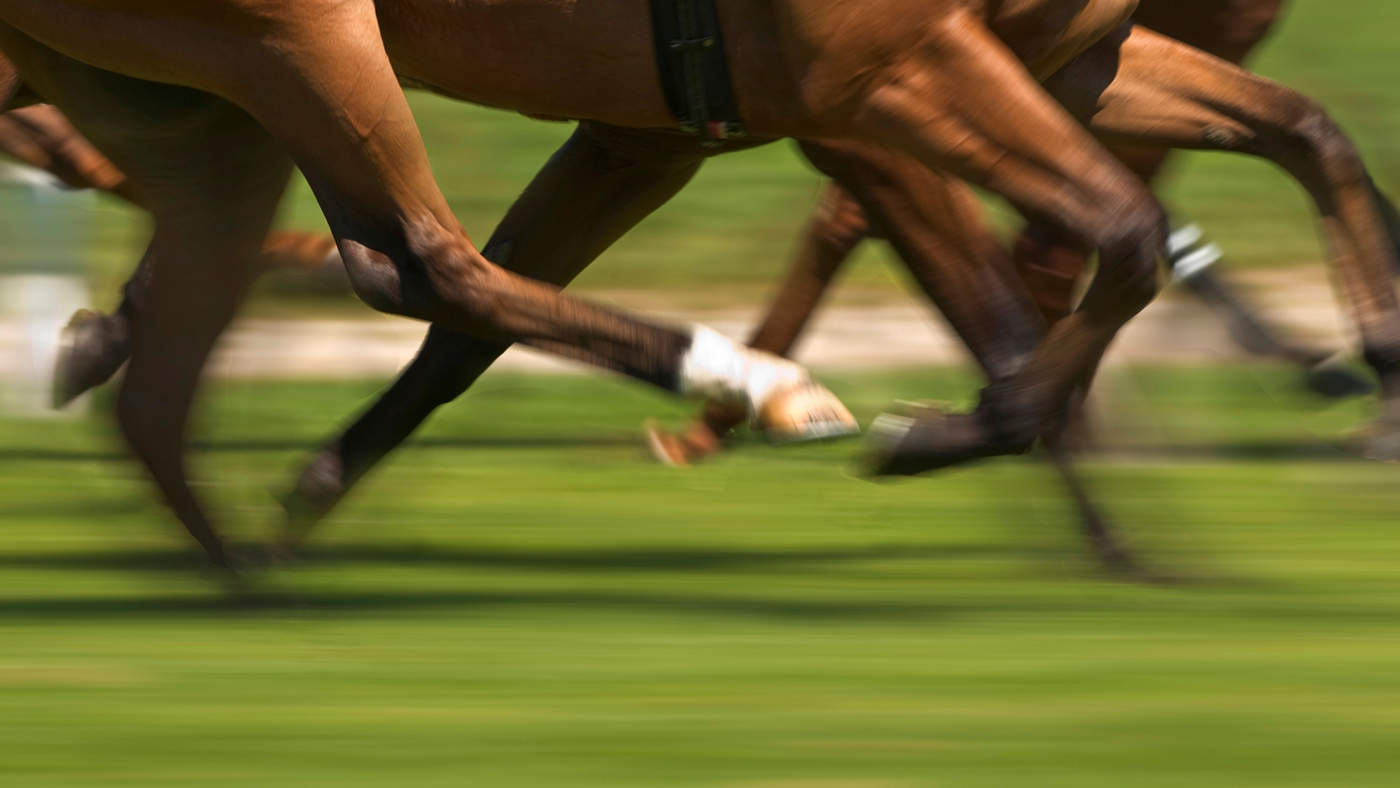How significant are soft tissue injuries within this complex joint? Matt Smith MRCVS explains
THE stifle is a hard-working joint with a large range of motion, which connects the horse’s thigh and crus (lower limb) regions.
It actually comprises two joints. The femoropatellar joint is located at the front of the stifle, between the ridges at the bottom of the femur and the patellar (the equivalent of our kneecap). The femorotibial joint sits between the bottom of the femur and the top of the tibia, and is divided into medial (inside) and lateral (outside) compartments.
Unlike in most joints, where the opposing cartilage surfaces fit into each other to create a smooth, gliding surface, the femorotibial joint features smooth discs of tissue called menisci, which sit between the ball-shaped ends of the femur and the plateau at the top of the tibia.
{"content":"PHA+QSBjb21wbGV4IGFycmF5IG9mIGxpZ2FtZW50cyBzdXBwb3J0cyB0aGUgc3RpZmxlIGFuZCBwcm92aWRlcyBzdGFiaWxpdHkuIE9uIHRoZSBpbnNpZGUgYW5kIG91dHNpZGUgYXJlIHRoZSBjb2xsYXRlcmFsIGxpZ2FtZW50cy4gVGhlIHBhdGVsbGFyIGxpZ2FtZW50cyBjb25uZWN0IHRoZSBwYXRlbGxhciB0byB0aGUgdGliaWEsIGF0IHRoZSBmcm9udCwgZm9ybWluZyBhIGZ1bmN0aW9uYWwgZXh0ZW5zaW9uIG9mIHRoZSBxdWFkcmljZXAgbXVzY2xlcy4gSW4gdGhlIGNlbnRyZSwgdGhlIGNyaXNzLWNyb3NzZWQgY3J1Y2lhdGUgbGlnYW1lbnRzIGNvbm5lY3QgdGhlIGJvdHRvbSBvZiB0aGUgZmVtdXIgYW5kIHRoZSB0b3Agb2YgdGhlIHRpYmlhLjwvcD4KPGgzPlRpc3N1ZSBpbmp1cmllczwvaDM+CjxwPlNUSUZMRSBpbmp1cmllcyBhcmUgcXVpdGUgY29tbW9uIGFuZCB0aGUgc29mdCB0aXNzdWUgc3RydWN0dXJlcyBhcmUgZnJlcXVlbnRseSBpbnZvbHZlZC4gVGhlIHJhbmdlIG9mIGlzc3VlcyBpcyBzaW1pbGFyIHRvIHRob3NlIHNlZW4gaW4gdGhlIGh1bWFuIGtuZWUsIHdpdGggbWVuaXNjYWwgaW5qdXJpZXMgb2NjdXJyaW5nIG1vcmUgb2Z0ZW4gdGhhbiBkYW1hZ2UgdG8gdGhlIGNydWNpYXRlIGFuZCBjb2xsYXRlcmFsIGxpZ2FtZW50cy48L3A+CjxwPjxkaXYgY2xhc3M9ImFkLWNvbnRhaW5lciBhZC1jb250YWluZXItLW1vYmlsZSI+PGRpdiBpZD0icG9zdC1pbmxpbmUtMiIgY2xhc3M9ImlwYy1hZHZlcnQiPjwvZGl2PjwvZGl2PjxzZWN0aW9uIGlkPSJlbWJlZF9jb2RlLTMxIiBjbGFzcz0iaGlkZGVuLW1kIGhpZGRlbi1sZyBzLWNvbnRhaW5lciBzdGlja3ktYW5jaG9yIGhpZGUtd2lkZ2V0LXRpdGxlIHdpZGdldF9lbWJlZF9jb2RlIHByZW1pdW1faW5saW5lXzIiPjxzZWN0aW9uIGNsYXNzPSJzLWNvbnRhaW5lciBsaXN0aW5nLS1zaW5nbGUgbGlzdGluZy0tc2luZ2xlLXNoYXJldGhyb3VnaCBpbWFnZS1hc3BlY3QtbGFuZHNjYXBlIGRlZmF1bHQgc2hhcmV0aHJvdWdoLWFkIHNoYXJldGhyb3VnaC1hZC1oaWRkZW4iPg0KICA8ZGl2IGNsYXNzPSJzLWNvbnRhaW5lcl9faW5uZXIiPg0KICAgIDx1bD4NCiAgICAgIDxsaSBpZD0ibmF0aXZlLWNvbnRlbnQtbW9iaWxlIiBjbGFzcz0ibGlzdGluZy1pdGVtIj4NCiAgICAgIDwvbGk+DQogICAgPC91bD4NCiAgPC9kaXY+DQo8L3NlY3Rpb24+PC9zZWN0aW9uPjwvcD4KPHA+SW5qdXJ5IHVzdWFsbHkgZm9sbG93cyB0cmF1bWEgdG8gdGhlIGpvaW50LiBMYW1lbmVzcywgb2Z0ZW4gc2V2ZXJlLCBpcyB1c3VhbGx5IHRoZSBmaXJzdCBjbHVlLiBXaGlsZSB0aGlzIGNhbiBpbXByb3ZlIHdpdGggcmVzdCwgbW9kZXJhdGUgbGFtZW5lc3MgdHlwaWNhbGx5IHBlcnNpc3RzLjwvcD4KPHA+Rmx1aWQgc3dlbGxpbmcgb2YgdGhlIHN0aWZsZSBqb2ludHMgd2lsbCBiZSBhcHBhcmVudCB3aGVuIHRoZSBsYW1lIGxlZyBpcyBleGFtaW5lZC4gSW4gdGhlIG1vc3Qgc2V2ZXJlIGluanVyaWVzLCB0aGVyZSBtYXkgYmUgaW5zdGFiaWxpdHkgb2YgdGhlIGpvaW50IGFuZCBvYnZpb3VzIHN3ZWxsaW5nIGFyb3VuZCB0aGUgc3RpZmxlIGFzIGEgcmVzdWx0IG9mIGludGVybmFsIGJsZWVkaW5nLiBMb2NhbGlzaW5nIHRoZSBjYXVzZSBvZiBsYW1lbmVzcyB0byB0aGUgc3RpZmxlIG1heSBiZSBwb3NzaWJsZSBmcm9tIGV4YW1pbmF0aW9uLCBidXQgbmVydmUgYmxvY2tzIG1heSBiZSBuZWNlc3NhcnkuPC9wPgo8cD48aW1nIGZldGNocHJpb3JpdHk9ImhpZ2giIGRlY29kaW5nPSJhc3luYyIgY2xhc3M9Imxhenlsb2FkIGJsdXItdXAgYWxpZ25ub25lIHNpemUtZnVsbCB3cC1pbWFnZS03NDE2NzEiIGRhdGEtcHJvY2Vzc2VkIHNyYz0iaHR0cHM6Ly9rZXlhc3NldHMudGltZWluY3VrLm5ldC9pbnNwaXJld3AvbGl2ZS93cC1jb250ZW50L3VwbG9hZHMvc2l0ZXMvMTQvMjAxNy8wMy9uZXctaGgtcGxhY2Vob2xkZXItMjAweDIwMC5wbmciIGRhdGEtc3JjPSJodHRwczovL2tleWFzc2V0cy50aW1laW5jdWsubmV0L2luc3BpcmV3cC9saXZlL3dwLWNvbnRlbnQvdXBsb2Fkcy9zaXRlcy8xNC8yMDIxLzAzL0hBSDI5OS52ZXRfLmZpZ3VyZV8xNl8xN192NC5qcGciIGFsdD0iIiB3aWR0aD0iMTQwMCIgaGVpZ2h0PSI3ODgiIGRhdGEtc2l6ZXM9ImF1dG8iIGRhdGEtc3Jjc2V0PSJodHRwczovL2tleWFzc2V0cy50aW1laW5jdWsubmV0L2luc3BpcmV3cC9saXZlL3dwLWNvbnRlbnQvdXBsb2Fkcy9zaXRlcy8xNC8yMDIxLzAzL0hBSDI5OS52ZXRfLmZpZ3VyZV8xNl8xN192NC5qcGcgMTQwMHcsIGh0dHBzOi8va2V5YXNzZXRzLnRpbWVpbmN1ay5uZXQvaW5zcGlyZXdwL2xpdmUvd3AtY29udGVudC91cGxvYWRzL3NpdGVzLzE0LzIwMjEvMDMvSEFIMjk5LnZldF8uZmlndXJlXzE2XzE3X3Y0LTMwMHgxNjkuanBnIDMwMHcsIGh0dHBzOi8va2V5YXNzZXRzLnRpbWVpbmN1ay5uZXQvaW5zcGlyZXdwL2xpdmUvd3AtY29udGVudC91cGxvYWRzL3NpdGVzLzE0LzIwMjEvMDMvSEFIMjk5LnZldF8uZmlndXJlXzE2XzE3X3Y0LTYzMHgzNTUuanBnIDYzMHcsIGh0dHBzOi8va2V5YXNzZXRzLnRpbWVpbmN1ay5uZXQvaW5zcGlyZXdwL2xpdmUvd3AtY29udGVudC91cGxvYWRzL3NpdGVzLzE0LzIwMjEvMDMvSEFIMjk5LnZldF8uZmlndXJlXzE2XzE3X3Y0LTEzNXg3Ni5qcGcgMTM1dywgaHR0cHM6Ly9rZXlhc3NldHMudGltZWluY3VrLm5ldC9pbnNwaXJld3AvbGl2ZS93cC1jb250ZW50L3VwbG9hZHMvc2l0ZXMvMTQvMjAyMS8wMy9IQUgyOTkudmV0Xy5maWd1cmVfMTZfMTdfdjQtMzIweDE4MC5qcGcgMzIwdywgaHR0cHM6Ly9rZXlhc3NldHMudGltZWluY3VrLm5ldC9pbnNwaXJld3AvbGl2ZS93cC1jb250ZW50L3VwbG9hZHMvc2l0ZXMvMTQvMjAyMS8wMy9IQUgyOTkudmV0Xy5maWd1cmVfMTZfMTdfdjQtNjIweDM0OS5qcGcgNjIwdywgaHR0cHM6Ly9rZXlhc3NldHMudGltZWluY3VrLm5ldC9pbnNwaXJld3AvbGl2ZS93cC1jb250ZW50L3VwbG9hZHMvc2l0ZXMvMTQvMjAyMS8wMy9IQUgyOTkudmV0Xy5maWd1cmVfMTZfMTdfdjQtOTIweDUxOC5qcGcgOTIwdywgaHR0cHM6Ly9rZXlhc3NldHMudGltZWluY3VrLm5ldC9pbnNwaXJld3AvbGl2ZS93cC1jb250ZW50L3VwbG9hZHMvc2l0ZXMvMTQvMjAyMS8wMy9IQUgyOTkudmV0Xy5maWd1cmVfMTZfMTdfdjQtMTIyMHg2ODcuanBnIDEyMjB3IiBzaXplcz0iKG1heC13aWR0aDogMTQwMHB4KSAxMDB2dywgMTQwMHB4IiAvPjwvcD4KPGRpdiBjbGFzcz0iYWQtY29udGFpbmVyIGFkLWNvbnRhaW5lci0tbW9iaWxlIj48ZGl2IGlkPSJwb3N0LWlubGluZS0zIiBjbGFzcz0iaXBjLWFkdmVydCI+PC9kaXY+PC9kaXY+CjxwPlVsdHJhc291bmQgaXMgZ2VuZXJhbGx5IG1vcmUgdXNlZnVsIHRoYW4gWC1yYXkgZm9yIGZ1cnRoZXIgaW52ZXN0aWdhdGlvbnMsIGJ1dCB0aGVyZSBhcmUgcHJvcyBhbmQgY29ucyB3aXRoIGVhY2ggdGVjaG5pcXVlLiBGcmFnbWVudHMgb2YgYm9uZSB0aGF0IGhhdmUgcHVsbGVkIGF3YXkgZnJvbSB0aGUgYXR0YWNobWVudCBzaXRlcyBvZiB0aGUgbWVuaXNjaSBhbmQgc3RpZmxlIGxpZ2FtZW50cyBjYW4gYmUgc2VlbiB3aXRoIFgtcmF5LCBhcyBjYW4gb3RoZXIgYWJub3JtYWxpdGllcyBzdWNoIGFzIHJlYWN0aXZlIGNoYW5nZXMgd2l0aGluIHRoZSBqb2ludHMuPC9wPgo8cD5XaGlsZSB1bHRyYXNvdW5kIGlzIHZlcnkgZWZmZWN0aXZlIGZvciBpbWFnaW5nIHRoZSBtZW5pc2NpIGFuZCBjb2xsYXRlcmFsIGxpZ2FtZW50cywgc2lnbmlmaWNhbnQgcG9ydGlvbnMgb2YgdGhlIG1lbmlzY2kgYmV0d2VlbiB0aGUgam9pbnQgc3VyZmFjZXMgYXJlIG5vdCB2aXNpYmxlLiBWaWV3cyBvZiB0aGUgY3J1Y2lhdGUgbGlnYW1lbnRzIGFyZSBhbHNvIGxpbWl0ZWQuPC9wPgo8ZGl2IGNsYXNzPSJhZC1jb250YWluZXIgYWQtY29udGFpbmVyLS1tb2JpbGUiPjxkaXYgaWQ9InBvc3QtaW5saW5lLTQiIGNsYXNzPSJpcGMtYWR2ZXJ0Ij48L2Rpdj48L2Rpdj4KPHA+TW9yZSBhZHZhbmNlZCBpbWFnaW5nIHRlY2huaXF1ZXMgbWF5IGJlIG5lZWRlZCB0byBlc3RhYmxpc2ggYSBkaWFnbm9zaXMuIEFydGhyb3Njb3B5IChrZXlob2xlIHN1cmdlcnkpIGlzIG9mdGVuIHVzZWQsIGFzIHRoaXMgYWxsb3dzIGRpcmVjdCBleGFtaW5hdGlvbiBvZiB0aGUgaW50ZXJpb3Igb2YgdGhlIGpvaW50cyBhbmQgb2ZmZXJzIHRoZSBiZXN0IHRyZWF0bWVudCBpbiBtYW55IGNhc2VzLjwvcD4KPHA+RXhwZXJpZW5jZSB3aXRoIGNvbXB1dGVkIHRvbW9ncmFwaHkgKENUKSBhbmQgbWFnbmV0aWMgcmVzb25hbmNlIGltYWdpbmcgKE1SSSkgaXMgZGV2ZWxvcGluZyBpbiB0aGUgaW52ZXN0aWdhdGlvbiBvZiBzdGlmbGUgaW5qdXJpZXMsIGFzIGJvdGggYWxsb3cgdGhvcm91Z2ggZXZhbHVhdGlvbiBvZiB0aGUgYm9uZSBhbmQgc29mdCB0aXNzdWVzLiBJdCBpcyBsaWtlbHkgdGhhdCB0aGVzZSB0ZWNobmlxdWVzIHdpbGwgYmVjb21lIG1vcmUgY29tbW9ubHkgdXNlZCwgYnV0IHRoZXkgYWRkIHNpZ25pZmljYW50IGV4cGVuc2UuPC9wPgo8ZGl2IGNsYXNzPSJhZC1jb250YWluZXIgYWQtY29udGFpbmVyLS1tb2JpbGUiPjxkaXYgaWQ9InBvc3QtaW5saW5lLTUiIGNsYXNzPSJpcGMtYWR2ZXJ0Ij48L2Rpdj48L2Rpdj4KPHA+PGltZyBkZWNvZGluZz0iYXN5bmMiIGNsYXNzPSJsYXp5bG9hZCBibHVyLXVwIGFsaWdubm9uZSBzaXplLWZ1bGwgd3AtaW1hZ2UtNzQxNjcwIiBkYXRhLXByb2Nlc3NlZCBzcmM9Imh0dHBzOi8va2V5YXNzZXRzLnRpbWVpbmN1ay5uZXQvaW5zcGlyZXdwL2xpdmUvd3AtY29udGVudC91cGxvYWRzL3NpdGVzLzE0LzIwMTcvMDMvbmV3LWhoLXBsYWNlaG9sZGVyLTIwMHgyMDAucG5nIiBkYXRhLXNyYz0iaHR0cHM6Ly9rZXlhc3NldHMudGltZWluY3VrLm5ldC9pbnNwaXJld3AvbGl2ZS93cC1jb250ZW50L3VwbG9hZHMvc2l0ZXMvMTQvMjAyMS8wMy9IQUgyOTkudmV0Xy5maWd1cmVfMTZfMTZfdjQuanBnIiBhbHQ9IiIgd2lkdGg9IjE0MDAiIGhlaWdodD0iNzg4IiBkYXRhLXNpemVzPSJhdXRvIiBkYXRhLXNyY3NldD0iaHR0cHM6Ly9rZXlhc3NldHMudGltZWluY3VrLm5ldC9pbnNwaXJld3AvbGl2ZS93cC1jb250ZW50L3VwbG9hZHMvc2l0ZXMvMTQvMjAyMS8wMy9IQUgyOTkudmV0Xy5maWd1cmVfMTZfMTZfdjQuanBnIDE0MDB3LCBodHRwczovL2tleWFzc2V0cy50aW1laW5jdWsubmV0L2luc3BpcmV3cC9saXZlL3dwLWNvbnRlbnQvdXBsb2Fkcy9zaXRlcy8xNC8yMDIxLzAzL0hBSDI5OS52ZXRfLmZpZ3VyZV8xNl8xNl92NC0zMDB4MTY5LmpwZyAzMDB3LCBodHRwczovL2tleWFzc2V0cy50aW1laW5jdWsubmV0L2luc3BpcmV3cC9saXZlL3dwLWNvbnRlbnQvdXBsb2Fkcy9zaXRlcy8xNC8yMDIxLzAzL0hBSDI5OS52ZXRfLmZpZ3VyZV8xNl8xNl92NC02MzB4MzU1LmpwZyA2MzB3LCBodHRwczovL2tleWFzc2V0cy50aW1laW5jdWsubmV0L2luc3BpcmV3cC9saXZlL3dwLWNvbnRlbnQvdXBsb2Fkcy9zaXRlcy8xNC8yMDIxLzAzL0hBSDI5OS52ZXRfLmZpZ3VyZV8xNl8xNl92NC0xMzV4NzYuanBnIDEzNXcsIGh0dHBzOi8va2V5YXNzZXRzLnRpbWVpbmN1ay5uZXQvaW5zcGlyZXdwL2xpdmUvd3AtY29udGVudC91cGxvYWRzL3NpdGVzLzE0LzIwMjEvMDMvSEFIMjk5LnZldF8uZmlndXJlXzE2XzE2X3Y0LTMyMHgxODAuanBnIDMyMHcsIGh0dHBzOi8va2V5YXNzZXRzLnRpbWVpbmN1ay5uZXQvaW5zcGlyZXdwL2xpdmUvd3AtY29udGVudC91cGxvYWRzL3NpdGVzLzE0LzIwMjEvMDMvSEFIMjk5LnZldF8uZmlndXJlXzE2XzE2X3Y0LTYyMHgzNDkuanBnIDYyMHcsIGh0dHBzOi8va2V5YXNzZXRzLnRpbWVpbmN1ay5uZXQvaW5zcGlyZXdwL2xpdmUvd3AtY29udGVudC91cGxvYWRzL3NpdGVzLzE0LzIwMjEvMDMvSEFIMjk5LnZldF8uZmlndXJlXzE2XzE2X3Y0LTkyMHg1MTguanBnIDkyMHcsIGh0dHBzOi8va2V5YXNzZXRzLnRpbWVpbmN1ay5uZXQvaW5zcGlyZXdwL2xpdmUvd3AtY29udGVudC91cGxvYWRzL3NpdGVzLzE0LzIwMjEvMDMvSEFIMjk5LnZldF8uZmlndXJlXzE2XzE2X3Y0LTEyMjB4Njg3LmpwZyAxMjIwdyIgc2l6ZXM9IihtYXgtd2lkdGg6IDE0MDBweCkgMTAwdncsIDE0MDBweCIgLz48L3A+CjxoMz5UcmVhdG1lbnQgb3B0aW9uczwvaDM+CjxwPk1VQ0ggb2Ygd2hhdCB3ZSBrbm93IGFib3V0IHNvZnQgdGlzc3VlIGluanVyaWVzIGluIHRoZSBzdGlmbGUgaGFzIGNvbWUgZnJvbSBvYnNlcnZhdGlvbnMgZHVyaW5nIGRpYWdub3N0aWMgaW52ZXN0aWdhdGlvbiBvZiBsYW1lIGhvcnNlcyB1c2luZyBhcnRocm9zY29weS48L3A+CjxwPkluanVyaWVzIG9mIHRoZSBtZW5pc2N1cyBtb3N0IGZyZXF1ZW50bHkgb2NjdXIgd2l0aGluIHRoZSBtZWRpYWwgZmVtb3JvdGliaWFsIGpvaW50LiBJbiBwZW9wbGUsIHRoZSBlbnRpcmV0eSBvZiB0aGUgdXBwZXIgc3VyZmFjZSBvZiB0aGUgbWVuaXNjaSBjYW4gYmUgZXZhbHVhdGVkIHdpdGggYXJ0aHJvc2NvcHksIGJ5IGFwcGx5aW5nIHRyYWN0aW9uIHRvIHRoZSBrbmVlIGFuZCBwdWxsaW5nIHRoZSBqb2ludCBzdXJmYWNlcyBhcGFydCB0byBnaXZlIHNwYWNlIHRvIGxvb2sgYXJvdW5kIHdpdGggdGhlIGFydGhyb3Njb3BlLiBUaGlzIGlzIG5vdCBwb3NzaWJsZSBpbiB0aGUgaG9yc2UsIGhvd2V2ZXIsIG1lYW5pbmcgdGhhdCBwb3J0aW9ucyBvZiB0aGUgbWVuaXNjdXMsIHBhcnRpY3VsYXJseSB0b3dhcmRzIHRoZSBjZW50cmUgb2YgdGhlIGpvaW50LCBjYW5ub3QgYmUgc2Vlbi4gSW5qdXJpZXMgaW4gdGhpcyBsb2NhdGlvbiBhcmUgYWxzbyBpbmFjY2Vzc2libGUgZm9yIGFydGhyb3Njb3BpYyB0cmVhdG1lbnQuPC9wPgo8cD5JbiB0aGUgbWFqb3JpdHkgb2YgY2FzZXMsIGFydGhyb3Njb3BpYyBzdXJnZXJ5IGludm9sdmVzIHJlbW92YWwsIG9yIOKAnGRlYnJpZGVtZW504oCdLCBvZiB0b3JuIGFuZCBkaXNydXB0ZWQgcG9ydGlvbnMgb2Ygc29mdCB0aXNzdWUuIFBhcnRpYWwgbWVuaXNjZWN0b215IChyZW1vdmFsIG9mIHRoZSBtZW5pc2N1cykgY2FuIGJlIHBlcmZvcm1lZCBvciwgd2l0aCBjcnVjaWF0ZSBsaWdhbWVudCBpbmp1cmllcywgdG9ybiBsaWdhbWVudCBmaWJyZXMgcmVtb3ZlZC48L3A+CjxwPkR1cmluZyBhcnRocm9zY29waWMgc3VyZ2VyeSwgdGhlIGNhcnRpbGFnZSBzdXJmYWNlcyBhcmUgYWxzbyBldmFsdWF0ZWQgZm9yIGFueSBhZGRpdGlvbmFsIGRhbWFnZSBvciBzaWducyBvZiBkZWdlbmVyYXRpdmUgKGFydGhyaXRpYykgY2hhbmdlLiBUaGUgaW5mb3JtYXRpb24gb2J0YWluZWQgcHJvdmlkZXMgdGhlIGJlc3QgZ3VpZGUgZm9yIHRoZSBob3JzZeKAmXMgY2hhbmNlcyBvZiByZWNvdmVyeSBmcm9tIGluanVyeS48L3A+CjxwPkludHJhLWFydGljdWxhciBtZWRpY2F0aW9ucyBtYXkgYmUgdXNlZCBhcyBhbiBhZGp1bmN0IHRvIGFydGhyb3Njb3BpYyB0cmVhdG1lbnQsIG9yLCB3aXRoIG1pbGQgaW5qdXJpZXMsIGFzIHRoZSBwcmltYXJ5IHRyZWF0bWVudC4gQW50aS1pbmZsYW1tYXRvcnkgaW5qZWN0aW9ucyBhcmUgY29tbW9ubHkgdXNlZCwgdHlwaWNhbGx5IGNvcnRpY29zdGVyb2lkcyBzdWNoIGFzIHRyaWFtY2lub2xvbmUgKHNpbWlsYXIgdG8gY29ydGlzb25lLCBvZnRlbiB1c2VkIGluIHBlb3BsZSkuPC9wPgo8cD5Zb3VyIHZldCBtYXkgcmVjb21tZW5kIGFsdGVybmF0aXZlIGludHJhLWFydGljdWxhciBtZWRpY2F0aW9uczsgZXhhbXBsZXMgaW5jbHVkZSBoeWFsdXJvbmljIGFjaWQsIHdoaWNoIGlzIGJvdGggYW50aS1pbmZsYW1tYXRvcnkgYW5kIHZpc2NvZWxhc3RpYyAoc2hvY2sgYWJzb3JiaW5nKSwgb3IgcG9seWFjcnlsYW1pZGUgZ2VsLCB3aGljaCBpcyB0aG91Z2h0IHRvIGZvcm0gYSBjdXNoaW9uLWxpa2UgbWVtYnJhbmUgYWZ0ZXIgaW5qZWN0aW9uLiBTdGVtIGNlbGxzIGhhdmUgYWxzbyBiZWVuIHJlc2VhcmNoZWQgZm9yIHRyZWF0bWVudCBvZiBtZW5pc2NhbCBpbmp1cmllcywgYW5kIG1heSBpbXByb3ZlIGhlYWxpbmcuPC9wPgo8cD5Gb2xsb3dpbmcgdHJlYXRtZW50LCBhbiBlZmZlY3RpdmUgcmVoYWJpbGl0YXRpb24gcHJvZ3JhbW1lIHdpbGwgaGVscCB0aGUgaG9yc2UgYmFjayBpbnRvIHdvcmsuPC9wPgo8cD48aW1nIGRlY29kaW5nPSJhc3luYyIgY2xhc3M9Imxhenlsb2FkIGJsdXItdXAgYWxpZ25ub25lIHNpemUtZnVsbCB3cC1pbWFnZS03NDE2NzQiIGRhdGEtcHJvY2Vzc2VkIHNyYz0iaHR0cHM6Ly9rZXlhc3NldHMudGltZWluY3VrLm5ldC9pbnNwaXJld3AvbGl2ZS93cC1jb250ZW50L3VwbG9hZHMvc2l0ZXMvMTQvMjAxNy8wMy9uZXctaGgtcGxhY2Vob2xkZXItMjAweDIwMC5wbmciIGRhdGEtc3JjPSJodHRwczovL2tleWFzc2V0cy50aW1laW5jdWsubmV0L2luc3BpcmV3cC9saXZlL3dwLWNvbnRlbnQvdXBsb2Fkcy9zaXRlcy8xNC8yMDIxLzAzL0hBSDI5OS52ZXRfLm1lZGlhbF9tZW5pc2N1c190ZWFyX2ZyZWVfY29udGVudF9jb21tLmpwZyIgYWx0PSIiIHdpZHRoPSIxNDAwIiBoZWlnaHQ9IjEwMTgiIGRhdGEtc2l6ZXM9ImF1dG8iIGRhdGEtc3Jjc2V0PSJodHRwczovL2tleWFzc2V0cy50aW1laW5jdWsubmV0L2luc3BpcmV3cC9saXZlL3dwLWNvbnRlbnQvdXBsb2Fkcy9zaXRlcy8xNC8yMDIxLzAzL0hBSDI5OS52ZXRfLm1lZGlhbF9tZW5pc2N1c190ZWFyX2ZyZWVfY29udGVudF9jb21tLmpwZyAxNDAwdywgaHR0cHM6Ly9rZXlhc3NldHMudGltZWluY3VrLm5ldC9pbnNwaXJld3AvbGl2ZS93cC1jb250ZW50L3VwbG9hZHMvc2l0ZXMvMTQvMjAyMS8wMy9IQUgyOTkudmV0Xy5tZWRpYWxfbWVuaXNjdXNfdGVhcl9mcmVlX2NvbnRlbnRfY29tbS0yNzV4MjAwLmpwZyAyNzV3LCBodHRwczovL2tleWFzc2V0cy50aW1laW5jdWsubmV0L2luc3BpcmV3cC9saXZlL3dwLWNvbnRlbnQvdXBsb2Fkcy9zaXRlcy8xNC8yMDIxLzAzL0hBSDI5OS52ZXRfLm1lZGlhbF9tZW5pc2N1c190ZWFyX2ZyZWVfY29udGVudF9jb21tLTU1MHg0MDAuanBnIDU1MHcsIGh0dHBzOi8va2V5YXNzZXRzLnRpbWVpbmN1ay5uZXQvaW5zcGlyZXdwL2xpdmUvd3AtY29udGVudC91cGxvYWRzL3NpdGVzLzE0LzIwMjEvMDMvSEFIMjk5LnZldF8ubWVkaWFsX21lbmlzY3VzX3RlYXJfZnJlZV9jb250ZW50X2NvbW0tMTM1eDk4LmpwZyAxMzV3LCBodHRwczovL2tleWFzc2V0cy50aW1laW5jdWsubmV0L2luc3BpcmV3cC9saXZlL3dwLWNvbnRlbnQvdXBsb2Fkcy9zaXRlcy8xNC8yMDIxLzAzL0hBSDI5OS52ZXRfLm1lZGlhbF9tZW5pc2N1c190ZWFyX2ZyZWVfY29udGVudF9jb21tLTMyMHgyMzMuanBnIDMyMHcsIGh0dHBzOi8va2V5YXNzZXRzLnRpbWVpbmN1ay5uZXQvaW5zcGlyZXdwL2xpdmUvd3AtY29udGVudC91cGxvYWRzL3NpdGVzLzE0LzIwMjEvMDMvSEFIMjk5LnZldF8ubWVkaWFsX21lbmlzY3VzX3RlYXJfZnJlZV9jb250ZW50X2NvbW0tNjIweDQ1MS5qcGcgNjIwdywgaHR0cHM6Ly9rZXlhc3NldHMudGltZWluY3VrLm5ldC9pbnNwaXJld3AvbGl2ZS93cC1jb250ZW50L3VwbG9hZHMvc2l0ZXMvMTQvMjAyMS8wMy9IQUgyOTkudmV0Xy5tZWRpYWxfbWVuaXNjdXNfdGVhcl9mcmVlX2NvbnRlbnRfY29tbS05MjB4NjY5LmpwZyA5MjB3LCBodHRwczovL2tleWFzc2V0cy50aW1laW5jdWsubmV0L2luc3BpcmV3cC9saXZlL3dwLWNvbnRlbnQvdXBsb2Fkcy9zaXRlcy8xNC8yMDIxLzAzL0hBSDI5OS52ZXRfLm1lZGlhbF9tZW5pc2N1c190ZWFyX2ZyZWVfY29udGVudF9jb21tLTEyMjB4ODg3LmpwZyAxMjIwdyIgc2l6ZXM9IihtYXgtd2lkdGg6IDE0MDBweCkgMTAwdncsIDE0MDBweCIgLz48L3A+CjxkaXYgaWQ9ImF0dGFjaG1lbnRfNzQxNjczIiBzdHlsZT0id2lkdGg6IDE0MTBweCIgY2xhc3M9IndwLWNhcHRpb24gYWxpZ25ub25lIj48aW1nIGxvYWRpbmc9ImxhenkiIGRlY29kaW5nPSJhc3luYyIgYXJpYS1kZXNjcmliZWRieT0iY2FwdGlvbi1hdHRhY2htZW50LTc0MTY3MyIgY2xhc3M9Imxhenlsb2FkIGJsdXItdXAgc2l6ZS1mdWxsIHdwLWltYWdlLTc0MTY3MyIgZGF0YS1wcm9jZXNzZWQgc3JjPSJodHRwczovL2tleWFzc2V0cy50aW1laW5jdWsubmV0L2luc3BpcmV3cC9saXZlL3dwLWNvbnRlbnQvdXBsb2Fkcy9zaXRlcy8xNC8yMDE3LzAzL25ldy1oaC1wbGFjZWhvbGRlci0yMDB4MjAwLnBuZyIgZGF0YS1zcmM9Imh0dHBzOi8va2V5YXNzZXRzLnRpbWVpbmN1ay5uZXQvaW5zcGlyZXdwL2xpdmUvd3AtY29udGVudC91cGxvYWRzL3NpdGVzLzE0LzIwMjEvMDMvSEFIMjk5LnZldF8ubWVkaWFsX21lbmlzY3VzX3RlYXJfYWZ0ZXJfZGVicmlkZW1lbnRfZnJlZV9jb250ZW50X2NvbW0uanBnIiBhbHQ9IiIgd2lkdGg9IjE0MDAiIGhlaWdodD0iMTAyOSIgZGF0YS1zaXplcz0iYXV0byIgZGF0YS1zcmNzZXQ9Imh0dHBzOi8va2V5YXNzZXRzLnRpbWVpbmN1ay5uZXQvaW5zcGlyZXdwL2xpdmUvd3AtY29udGVudC91cGxvYWRzL3NpdGVzLzE0LzIwMjEvMDMvSEFIMjk5LnZldF8ubWVkaWFsX21lbmlzY3VzX3RlYXJfYWZ0ZXJfZGVicmlkZW1lbnRfZnJlZV9jb250ZW50X2NvbW0uanBnIDE0MDB3LCBodHRwczovL2tleWFzc2V0cy50aW1laW5jdWsubmV0L2luc3BpcmV3cC9saXZlL3dwLWNvbnRlbnQvdXBsb2Fkcy9zaXRlcy8xNC8yMDIxLzAzL0hBSDI5OS52ZXRfLm1lZGlhbF9tZW5pc2N1c190ZWFyX2FmdGVyX2RlYnJpZGVtZW50X2ZyZWVfY29udGVudF9jb21tLTI3MngyMDAuanBnIDI3MncsIGh0dHBzOi8va2V5YXNzZXRzLnRpbWVpbmN1ay5uZXQvaW5zcGlyZXdwL2xpdmUvd3AtY29udGVudC91cGxvYWRzL3NpdGVzLzE0LzIwMjEvMDMvSEFIMjk5LnZldF8ubWVkaWFsX21lbmlzY3VzX3RlYXJfYWZ0ZXJfZGVicmlkZW1lbnRfZnJlZV9jb250ZW50X2NvbW0tNTQ0eDQwMC5qcGcgNTQ0dywgaHR0cHM6Ly9rZXlhc3NldHMudGltZWluY3VrLm5ldC9pbnNwaXJld3AvbGl2ZS93cC1jb250ZW50L3VwbG9hZHMvc2l0ZXMvMTQvMjAyMS8wMy9IQUgyOTkudmV0Xy5tZWRpYWxfbWVuaXNjdXNfdGVhcl9hZnRlcl9kZWJyaWRlbWVudF9mcmVlX2NvbnRlbnRfY29tbS0xMzV4MTAwLmpwZyAxMzV3LCBodHRwczovL2tleWFzc2V0cy50aW1laW5jdWsubmV0L2luc3BpcmV3cC9saXZlL3dwLWNvbnRlbnQvdXBsb2Fkcy9zaXRlcy8xNC8yMDIxLzAzL0hBSDI5OS52ZXRfLm1lZGlhbF9tZW5pc2N1c190ZWFyX2FmdGVyX2RlYnJpZGVtZW50X2ZyZWVfY29udGVudF9jb21tLTMyMHgyMzUuanBnIDMyMHcsIGh0dHBzOi8va2V5YXNzZXRzLnRpbWVpbmN1ay5uZXQvaW5zcGlyZXdwL2xpdmUvd3AtY29udGVudC91cGxvYWRzL3NpdGVzLzE0LzIwMjEvMDMvSEFIMjk5LnZldF8ubWVkaWFsX21lbmlzY3VzX3RlYXJfYWZ0ZXJfZGVicmlkZW1lbnRfZnJlZV9jb250ZW50X2NvbW0tNjIweDQ1Ni5qcGcgNjIwdywgaHR0cHM6Ly9rZXlhc3NldHMudGltZWluY3VrLm5ldC9pbnNwaXJld3AvbGl2ZS93cC1jb250ZW50L3VwbG9hZHMvc2l0ZXMvMTQvMjAyMS8wMy9IQUgyOTkudmV0Xy5tZWRpYWxfbWVuaXNjdXNfdGVhcl9hZnRlcl9kZWJyaWRlbWVudF9mcmVlX2NvbnRlbnRfY29tbS05MjB4Njc2LmpwZyA5MjB3LCBodHRwczovL2tleWFzc2V0cy50aW1laW5jdWsubmV0L2luc3BpcmV3cC9saXZlL3dwLWNvbnRlbnQvdXBsb2Fkcy9zaXRlcy8xNC8yMDIxLzAzL0hBSDI5OS52ZXRfLm1lZGlhbF9tZW5pc2N1c190ZWFyX2FmdGVyX2RlYnJpZGVtZW50X2ZyZWVfY29udGVudF9jb21tLTEyMjB4ODk3LmpwZyAxMjIwdyIgc2l6ZXM9IihtYXgtd2lkdGg6IDE0MDBweCkgMTAwdncsIDE0MDBweCIgLz48cCBpZD0iY2FwdGlvbi1hdHRhY2htZW50LTc0MTY3MyIgY2xhc3M9IndwLWNhcHRpb24tdGV4dCI+TWVuaXNjYWwgdGVhcnMgbW9zdCBmcmVxdWVudGx5IG9jY3VyIGluIHRoZSBtZWRpYWwgZmVtb3JvdGliaWFsIGpvaW50LiBUaGUgbGVmdCBzY2FuIHNob3dzIGEgdGVhciBiZWZvcmUgdHJlYXRtZW50LCBhbmQgdGhlIHJpZ2h0IGZvbGxvd2luZyBkZWJyaWRlbWVudCAocmVtb3ZhbCkgb2YgdG9ybiB0aXNzdWU8L3A+PC9kaXY+CjxoMz5UaGUgcHJvZ25vc2lzPC9oMz4KPHA+TUFOWSBob3JzZXMgY2FuIG1ha2UgYSByZXR1cm4gdG8gZnVsbCBjb21wZXRpdGl2ZSBzb3VuZG5lc3MgZm9sbG93aW5nIGFydGhyb3Njb3BpYyBzdXJnaWNhbCB0cmVhdG1lbnQuIFRoZSBwcm9nbm9zaXMgZGVwZW5kcyB1cG9uIHRoZSBleHRlbnQgb2YgdGhlIGluanVyeS4gV2l0aCBtZW5pc2NhbCBpbmp1cmllcywgYXBwcm94aW1hdGVseSB0d28tdGhpcmRzIG9mIGhvcnNlcyB3aXRoIG1pbm9yIHRlYXJzIHJlY292ZXIgZnVsbHkuIFRoaXMgZmFsbHMgdG8gY2xvc2VyIHRvIDUwJSB3aXRoIG1vZGVyYXRlbHkgc2V2ZXJlIHRlYXJzOyBpbiB0aGUgd29yc3QgaW5qdXJpZXMsIHZlcnkgZmV3IGNhbiByZXN1bWUgd29yay48L3A+CjxwPkluanVyaWVzIG9mIHRoZSBjcmFuaWFsIGNydWNpYXRlIGxpZ2FtZW50IHRyZWF0ZWQgYnkgYXJ0aHJvc2NvcGljIHN1cmdpY2FsIGRlYnJpZGVtZW50IGdlbmVyYWxseSBoYXZlIGEgZmFpciBwcm9nbm9zaXMsIHdpdGggYXBwcm94aW1hdGVseSBoYWxmIG9mIGhvcnNlcyByZXBvcnRlZCB3aXRoIHRoaXMgaW5qdXJ5IHJlc3VtaW5nIGEgY29tcGV0aXRpdmUgY2FyZWVyLjwvcD4KPHA+U2FkbHksIGhvcnNlcyB3aG8gc3VzdGFpbiBhIGNvbXBsZXRlIHJ1cHR1cmUgb2YgZWl0aGVyIG9mIHRoZSBjcnVjaWF0ZSBsaWdhbWVudHMgYXJlIHVuYWJsZSB0byB3b3JrIGFnYWluLiBJbiB0aGUgbW9zdCBzZXZlcmUgc29mdCB0aXNzdWUgaW5qdXJpZXMsIHN0YWJpbGl0eSBvZiB0aGUgam9pbnQgbWF5IG5ldmVyIGNvbXBsZXRlbHkgcmV0dXJuIGFuZCBhcnRocml0aXMgaXMgbGlrZWx5IHRvIGRldmVsb3AsIHdpdGggYXNzb2NpYXRlZCBwZXJzaXN0ZW50IGxhbWVuZXNzLjwvcD4KPGgzPlRoZSB2ZXQ8L2gzPgo8ZGl2IGNsYXNzPSJpbmplY3Rpb24iPjwvZGl2Pgo8cD5NQVRUIFNNSVRIIE1SQ1ZTIGlzIGEgc3VyZ2VvbiBhbmQgcGFydG5lciBhdCBOZXdtYXJrZXQgRXF1aW5lIEhvc3BpdGFsIChORUgpLiBUaGlzIHJlZmVycmFsIGhvc3BpdGFsIGlzIG9uZSBvZiB0aGUgbGFyZ2VzdCBpbiBFdXJvcGUsIHRyZWF0aW5nIGEgd2lkZSByYW5nZSBvZiBsZWlzdXJlIGFuZCBzcG9ydCBob3JzZXMgZnJvbSBhbGwgb3ZlciB0aGUgVUsuIE1hdHQgaXMgYSBSb3lhbCBDb2xsZWdlIG9mIFZldGVyaW5hcnkgU3VyZ2VvbnMgKFJDVlMpIHNwZWNpYWxpc3QgaW4gZXF1aW5lIHN1cmdlcnkgYW5kIGhhcyBhIHBhcnRpY3VsYXIgaW50ZXJlc3QgaW4gb3J0aG9wYWVkaWMgcHJvYmxlbXMuIDAxNjM4IDc4MjAyMCwgbmV3bWFya2V0ZXF1aW5laG9zcGl0YWwuY29tPC9wPgo8cD4K"}
This feature is also available to read in this Thursday’s H&H magazine (1 April, 2021)
You may also be interested in…
Library image.
Credit: Alamy Stock Photo
Sharp contact between a hind hoof and a foreleg can cause significant injury, as Dr David Stack MRCVS explains




